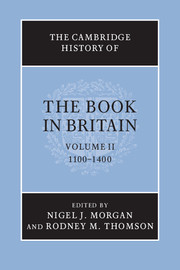Book contents
- Frontmatter
- Preface
- The roles of books
- Book production
- Readership, libraries, texts and contexts
- 9 Library catalogues and indexes
- 10 University and monastic texts
- 11 Law
- 12 Books for the liturgy and private prayer
- 13 Compilations for preaching and Lollard literature
- 14 Spiritual writings and religious instruction
- 15 Vernacular literature and its readership
- 16 History and history books
- 17 Archive books
- 18 Scientific and medical writings
- 19 Music
- 20 Illustration and ornament
- List of abbreviations
- Bibliography
- Photo credits
- General index
- Index of manuscripts
- Plates 1
- Plates 2
- References
9 - Library catalogues and indexes
from Readership, libraries, texts and contexts
Published online by Cambridge University Press: 28 November 2008
- Frontmatter
- Preface
- The roles of books
- Book production
- Readership, libraries, texts and contexts
- 9 Library catalogues and indexes
- 10 University and monastic texts
- 11 Law
- 12 Books for the liturgy and private prayer
- 13 Compilations for preaching and Lollard literature
- 14 Spiritual writings and religious instruction
- 15 Vernacular literature and its readership
- 16 History and history books
- 17 Archive books
- 18 Scientific and medical writings
- 19 Music
- 20 Illustration and ornament
- List of abbreviations
- Bibliography
- Photo credits
- General index
- Index of manuscripts
- Plates 1
- Plates 2
- References
Summary
The centuries between 1100 and 1400 witnessed the development of book-lists from simple lists into descriptive catalogues, arranged according to a variety of different principles. Before the end of the fourteenth century experiments were being made in employing the fixed order of the alphabet to help, either as an organizing principle or, more commonly, as a means of indexing a catalogue arranged on other principles. The birth of the library catalogue resulted from a change of approach to the custody of and access to books in particular institutions. Its sophistication as a document depended on years of evolution as librarians experimented with different ways of describing books and organizing lists. The origins of the catalogue lie in documents of a much less formal character.
A list of books might be drawn up for many reasons in a wide range of circumstances – books owned by someone, books copied by someone, books that were changing hands between owners. No doubt an equally wide variety of impulses motivated individuals to make lists of their books, but in institutions, where responsibility for the books would pass from one person to another, perhaps at quite short intervals, the need for a record of what books the institution possessed was widely felt. Such lists might well distinguish books kept for study from books kept for liturgical purposes; books kept for administrative reasons, such as custumals and cartularies, were rarely listed at all.
- Type
- Chapter
- Information
- The Cambridge History of the Book in Britain , pp. 195 - 218Publisher: Cambridge University PressPrint publication year: 2008
References
- 2
- Cited by



